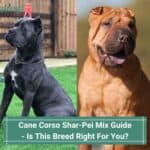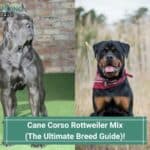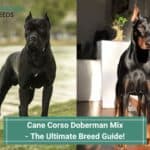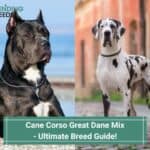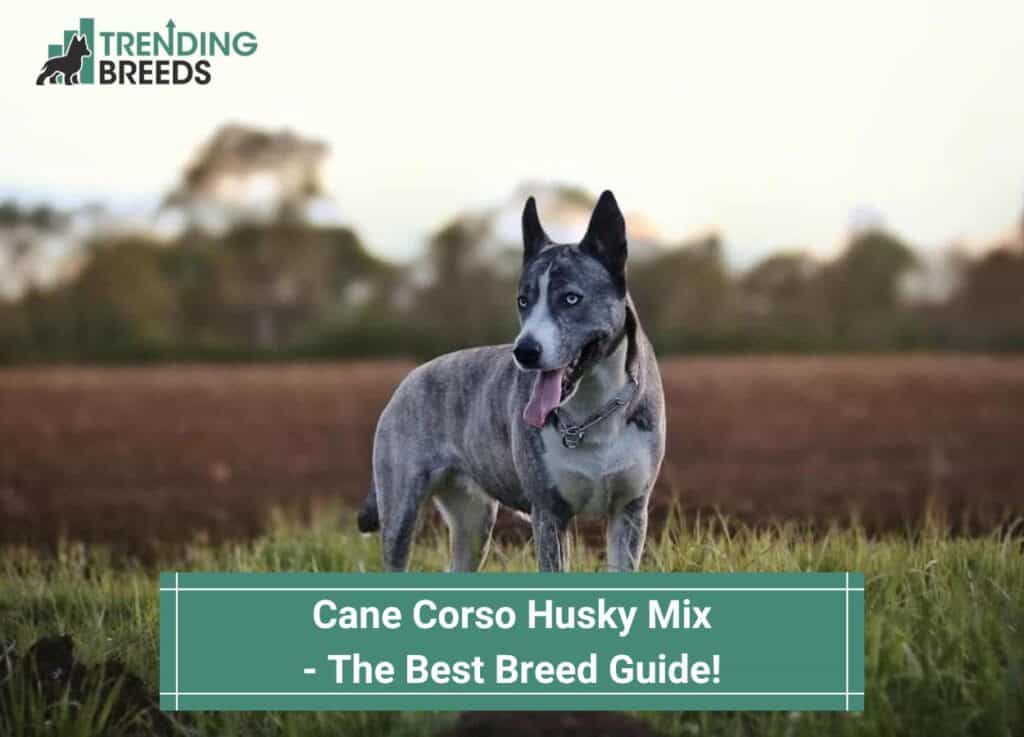
Are you looking to adopt a Cane Corso Husky mix but aren’t sure if it’s the right dog for you?
Well, you’ve come to the right place because we’ll tell you everything you need to know about this giant fluffy pooch, including physical appearance, personality traits, history, and more.
Other articles you would like: Meet The Belusky and Cane Corso Lifespan
Table of Contents
Overview of the Cane Corso/Husky
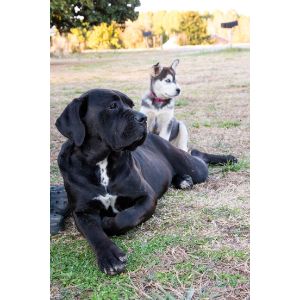
The Cane Corso Husky is a cross between the Cane Corso and the Husky. They are best known for being a strong, reliable, intelligent, and incredibly loyal breed.
Due to their high strength and agility, many dogs participate in athletic events and work as guard dogs. Since they’re pretty smart, training them is easy but also necessary since they can get a bit over-defensive of their owners.
The Husky Cane Corso is a medium to large dog and responds well to love and affection. Despite their size, they are excellent family dogs and get along well with children of all ages (they’re gentle giants, after all).
Cane Corso History
The Cane Corso is a massive dog, usually weighing well over 100 pounds. They are believed to have descended from ancient Italy as Roman war dogs and have a long history alongside humankind.
During times of peace, they were known to be farm hands (herding livestock and chasing off wolves), guard dogs, and hunters. This history established their role as reliable working dogs for centuries to come.
That is, until they were pushed to the brink of extinction.
There aren’t any records to indicate what happened precisely, but many think it was a side effect of shifting farming practices during the 20th century and two world wars.
Fortunately, due to independent revival efforts, the breed returned and has become one of the most popular dog breeds.
Husky History
The Husky, specifically the Siberian Husky, is a medium-sized, almost large dog weighing between 40 and 60 pounds. Like the Cane Corso, the Husky has a long-standing relationship with humans as a working dog and amiable companion.
Huskies are one of the oldest domestic dog breeds and originated in Russia as sled dogs. Because of this, they are not only strong but have extremely high endurance.
They made their way to Alaska in the early 1900s. Since then, they have become popular race dogs and pets.
Cane Corso Husky Traits
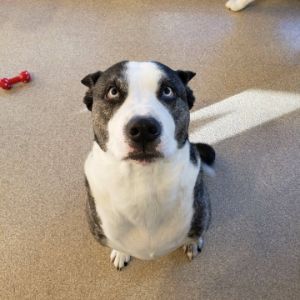
No two Cane Corso Huskies are precisely the same. They usually receive a random mix of traits from their parents, resulting in unique and beautiful combinations.
While even pups from the same litter will probably look different from each other, here’s a general guide on what to expect from this mix.
Physical Appearance
As stated earlier, the Cane Corso Husky can take on any physical traits from its parents, so knowing about the two breeds is essential in understanding potential offspring outcomes.
Husky Appearance
Huskies have a similar appearance to wolves, although smaller and vastly more gentle. Their eyes are typically blue or hazel, but they can also come in black. It is also common for their eyes to be heterochromatic or two different colors.
Their ears are a pointy triangular shape, and their tails are bushy. Furthermore, they have a thick coat that has acclimated to cold climates.
Cane Corso Appearance
The Cane Corso sports a toned build. They have a prominently broad chest, thick hind legs for running, and large, stern faces.
Their ears are large and droop downward, while their tails are long. It is a common practice to crop the ears and dock the tail for cosmetic reasons. However, this practice isn’t recommended.
Many Cane Corsos have blue eyes as puppies that change to shades of brown, amber, and yellow as they age.
Fur Coat: Color and Texture
Once again, their coat color is entirely random and can come in different variations.
The Husky may have a solid gray, white, or black coat but are better known for its multi-colored variations. Huskies can come in browns and reds and may have distinguishable markings around their bodies and legs.
On the other hand, Cane Corsos only come in solid colors of:
- Gray
- Brown
- Red
- Black
Occasionally, they may be born with a black or brown face mask and tiger-like stripes on their body.
As for their coat, it’s typically a short, smooth, and soft variation, although it can sometimes be longer if the Husky parent’s traits are more dominant.
Weight and Size
Both breeds are large. Since Cane Corsos weigh up to 110 pounds and Huskies can weigh as little as 35 pounds, you can expect their weight to fall between these numbers.
Height-wise, they’ll likely fall into the 20 – 27 inch range.
There’s no real way to tell how much they’ll grow, so if you adopt one, it’s best to prepare to have a large dog in the household.
Shedding
Unfortunately, Cane Corso Huskies are pretty heavy shedders. Since Cane Corsos and Huskies shed quite a bit, you can expect the same for the crossbreed.
They shed the most in spring and fall, and brushing them multiple times a week is recommended to control it (or risk having your house coated in clumps of dog fur). Additionally, it would be best to bathe them every two to three months.
Hypoallergenic
Sadly, the Cane Corso Husky is not hypoallergenic. People with dog allergies should stay away since they shed abundant fur and dander.
Cane Corso Husky Personality, Sociability, and Temperament
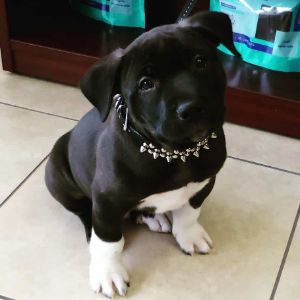
The personality can differ from dog to dog, but it is generally accepted that the Husky Cane Corso mix is exceptionally loyal and loving.
They may be strongly inclined to protect their owners but are often gentle and kind. They typically won’t be too aggressive unless they sense hostility towards those they love.
Of course, with proper training, you can eliminate any threat of them hurting anyone (which is only done to protect you in the first place).
Cane Corso Huskies are also known to have jealousy issues. Attention to other pets or people may spark these feelings, though they’ll cope if you give them hearty love.
Despite this, they still get along well with other animals and people. Socialization training is crucial at a young age so they can become familiar with meeting strangers and new pets.
Additionally, you can expect your Cane Corso Husky mix to be an energetic, playful ball of fur.
They love pleasing their owners and are relentless when it comes time to play. This breed won’t bark, but they will howl and growl, so be wary of that.
The Cane Corso Husky is a friendly, brave, and lively breed that loves to please and love its owner.
The Cane Corso Husky Mix as a Working Dog
Since Huskies and Cane Corsos have historically been working dogs, the Cane Corso Husky hybrid is no exception. You can train this breed to work as a guard dog or a support animal.
Caring for a Cane Corso Husky
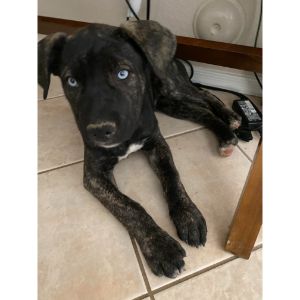
Taking care of a Cane Corso Husky is not easy, but it’s rewarding. Here are some crucial factors to consider about this breed.
Life Span
The average life expectancy for the Cane Corso Husky is between 10 and 14 years. Since they are large dogs, their lifespan isn’t quite as long as other, smaller breeds.
Diet
Cane Corso Huskies need huge quantities of high-quality food. A wide spread of nutrients is essential for their growth and high daily energy output.
As such, you should feed them three times a day as pups and at least two times a day when they are fully grown adults with substantial portions. Exact measurements will depend on the size and weight of your dog.
They need to be fed food that is high in protein and carbohydrates. To get a better idea of your dog’s specific dietary needs, it is advised to consult a vet or dog dietician.
Exercise and Play
Cane Corso Husky mixes are energetic and need lots of activity.
You should try to play with your pet for at least 45 – 60 minutes a day, although they’ll appreciate it if you can manage more. This requirement means plenty of walks (runs if you can), ball throws, and any other high-stimulation play measures you have.
They also like swimming and going to the park. If you have other dogs of similar size, they’ll also enjoy playing with them.
Make sure you give them lots of exercise. Otherwise, you may develop destructive habits, such as destroying furniture, howling excessively, and digging holes. Of course, this isn’t done intentionally; it’s just a side effect of their pent-up energy and boredom.
If you cannot put in the time to give this breed the exercise and playtime it needs, it’s best to stay away from adopting one.
Living Space
Cane Corso Huskies aren’t the best apartment dogs. They take up a lot of space, and there isn’t much room for play on rainy days.
They do make great companions in small to medium-sized houses, just as long as there is adequate space for them to move around. They’re great family dogs but have to be appropriately trained, especially when small children and other pets are involved.
Trainability and Intelligence
As mentioned above, training from a young age is crucial for the Cane Corso Husky. You’ve got to make sure that they don’t attack people they might accidentally perceive as hostile and socialize them when they’re still puppies.
That means introducing them to other people and animals and training them to control their overprotective instincts.
Fortunately, training them should be a cinch since they’re pretty smart. This breed responds impeccably well to positive reinforcement and is always up to being mentally challenged.
Health Issues
Since Husky Cane Corsos are a bit bigger, they’re prone to several health risks. Knowing these conditions beforehand can help you better prepare and know when something is wrong with your dog.
Here are some of the most common health issues for Cane Corso Husky mixes.
Eye Problems
Cane Corso Huskies are prone to many eye issues, such as cataracts and progressive retinal atrophy (PRA), which cause your dog to lose vision over time.
They may also develop cherry eye, entropion, and dystrophy, so it’s best to take your dog to the vet for checkups regularly.
Bloat
When your dog’s stomach fills up with gas or liquid, it can cause the appendage to shift and cause abdominal pain.
This condition is common in big dogs and is always a medical emergency that requires surgery.
Hip Dysplasia
Hip dysplasia is essentially when your dog’s ball and hip sockets don’t align quite the right way. This condition results in joint pain, discomfort, and trouble moving.
Hypothyroidism
As your dog gets older, it may develop hypothyroidism.
This condition will cause your Cane Corso Husky’s metabolism to slow, making them more susceptible to weight gain, fatigue, and shedding.
Cost Of Cane Corso Husky Mix
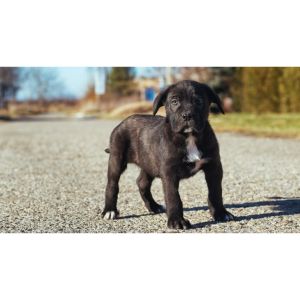
The average cost of the Cane Corso Husky mix can get a bit pricey, ranging between $500 and $1500. They aren’t the most common breed, but they’re still excellent pets overall.
When contacting a breeder, make sure that they’re reputable and responsible. Doing so will allow your pet to live a healthier and higher quality of life.
Cane Corso Husky Mix – The Best Breed Guide!
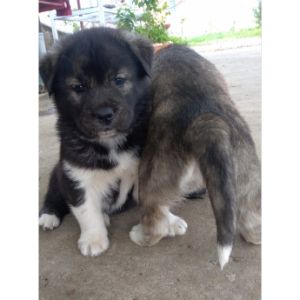
Cane Corso Husky mixes have a long history as human companions and hold high loyalty and love for their owners.
Taking care of them may require a lot of high-demand maintenance, but if you’re willing to remain attentive, they’ll stick by your side for as long as they live. After all, there’s nothing more satisfying than a fluffy best friend who’ll follow you anywhere.
In the end, few other breeds come close to being as noble and dependable as the Cane Corso Husky mix.
You will also like:
- Golden Retriever And Husky Mix
- Cane Corso Shar-Pei Mix Guide
- Cane Corso Tails – To Dock Or Not To Dock?
For more Husky Mixes, check out the video below:

